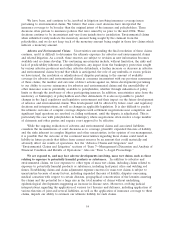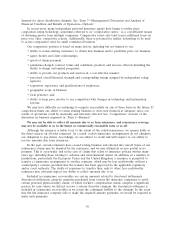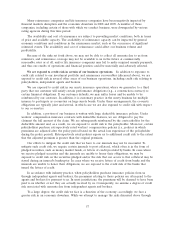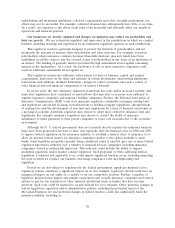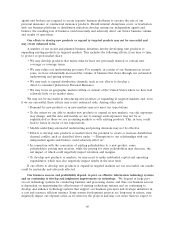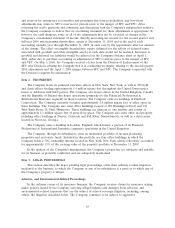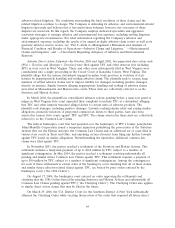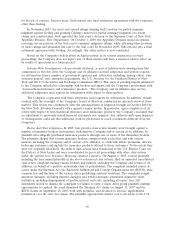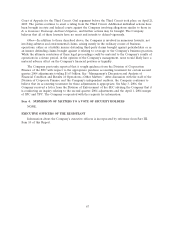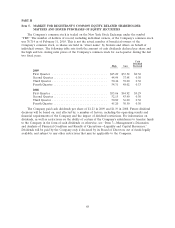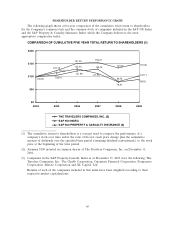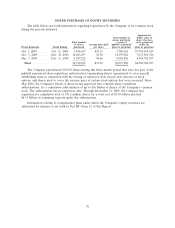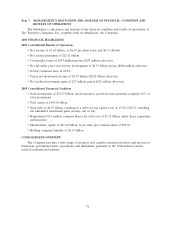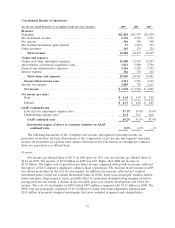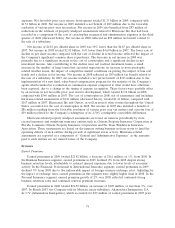Travelers 2009 Annual Report Download - page 76
Download and view the complete annual report
Please find page 76 of the 2009 Travelers annual report below. You can navigate through the pages in the report by either clicking on the pages listed below, or by using the keyword search tool below to find specific information within the annual report.asbestos-related litigation. The conditions surrounding the final resolution of these claims and the
related litigation continue to change. The Company is defending its asbestos- and environmental-related
litigation vigorously and believes that it has meritorious defenses; however, the outcomes of these
disputes are uncertain. In this regard, the Company employs dedicated specialists and aggressive
resolution strategies to manage asbestos and environmental loss exposure, including settling litigation
under appropriate circumstances. For other information regarding the Company’s asbestos and
environmental exposure, including the results of its annual in-depth asbestos claim review as well as its
quarterly asbestos reserve review, see ‘‘Part I—Item 2—Management’s Discussion and Analysis of
Financial Condition and Results of Operations—Asbestos Claims and Litigation,’’ ‘‘—Environmental
Claims and Litigation’’ and ‘‘—Uncertainty Regarding Adequacy of Asbestos and Environmental
Reserves.’’
Asbestos Direct Action Litigation—In October 2001 and April 2002, two purported class action suits
(Wise v. Travelers and Meninger v. Travelers) were filed against TPC and other insurers (not including
SPC) in state court in West Virginia. These and other cases subsequently filed in West Virginia were
consolidated into a single proceeding in the Circuit Court of Kanawha County, West Virginia. The
plaintiffs allege that the insurer defendants engaged in unfair trade practices in violation of state
statutes by inappropriately handling and settling asbestos claims. The plaintiffs seek to reopen large
numbers of settled asbestos claims and to impose liability for damages, including punitive damages,
directly on insurers. Similar lawsuits alleging inappropriate handling and settling of asbestos claims
were filed in Massachusetts and Hawaii state courts. These suits are collectively referred to as the
Statutory and Hawaii Actions.
In March 2002, the plaintiffs in consolidated asbestos actions pending before a mass tort panel of
judges in West Virginia state court amended their complaint to include TPC as a defendant, alleging
that TPC and other insurers breached alleged duties to certain users of asbestos products. The
plaintiffs seek damages, including punitive damages. Lawsuits seeking similar relief and raising similar
allegations, primarily violations of purported common law duties to third parties, have also been
asserted in various state courts against TPC and SPC. The claims asserted in these suits are collectively
referred to as the Common Law Claims.
The federal bankruptcy court that had presided over the bankruptcy of TPC’s former policyholder
Johns-Manville Corporation issued a temporary injunction prohibiting the prosecution of the Statutory
Actions (but not the Hawaii Actions), the Common Law Claims and an additional set of cases filed in
various state courts in Texas and Ohio, and enjoining certain attorneys from filing any further lawsuits
against TPC based on similar allegations. Notwithstanding the injunction, additional common law
claims were filed against TPC.
In November 2003, the parties reached a settlement of the Statutory and Hawaii Actions. This
settlement includes a lump-sum payment of up to $412 million by TPC, subject to a number of
significant contingencies. In May 2004, the parties reached a settlement resolving substantially all
pending and similar future Common Law Claims against TPC. This settlement requires a payment of
up to $90 million by TPC, subject to a number of significant contingencies. Among the contingencies
for each of these settlements is a final order of the bankruptcy court clarifying that all of these claims,
and similar future asbestos-related claims against TPC, are barred by prior orders entered by the
bankruptcy court (‘‘the 1986 Orders’’).
On August 17, 2004, the bankruptcy court entered an order approving the settlements and
clarifying that the 1986 Orders barred the pending Statutory and Hawaii Actions and substantially all
Common Law Claims pending against TPC (‘‘the Clarifying Order’’). The Clarifying Order also applies
to similar direct action claims that may be filed in the future.
On March 29, 2006, the U.S. District Court for the Southern District of New York substantially
affirmed the Clarifying Order while vacating that portion of the order that required all future direct
64


